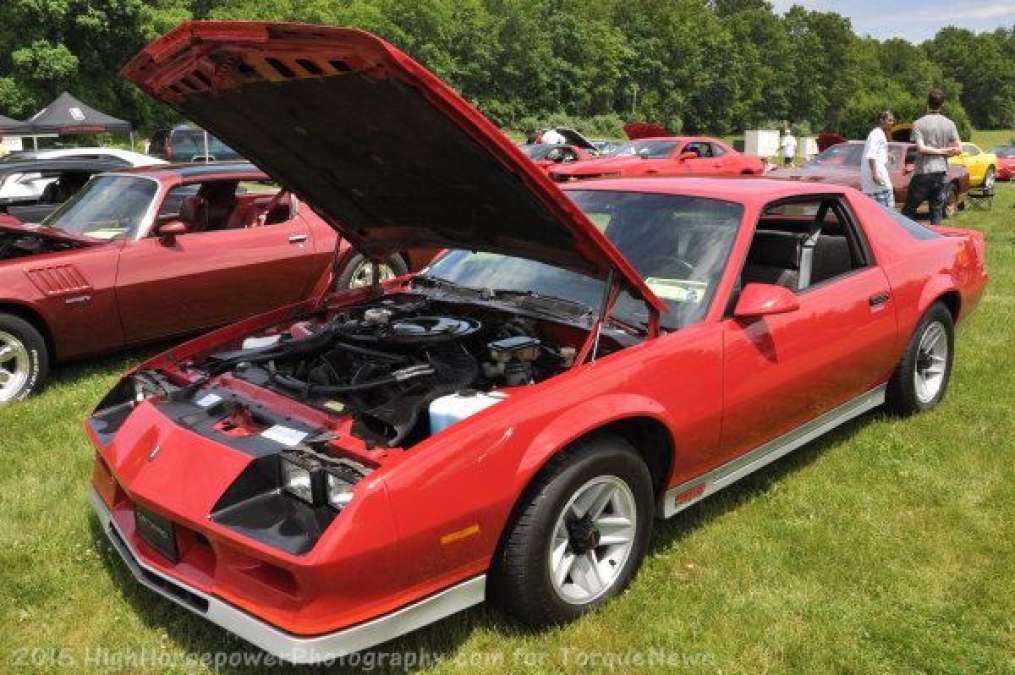Last week, we brought you a detailed look at the engine options for the 1st and 2nd generation of the Chevrolet Camaro, after General Motors had rolled out a brief engine history of their own. Those first two installments covered the early glory years of the GM muscle car, but with the arrival of the 3rd gen Camaro in 1982 came growing concerns about fuel economy. Because of this, Camaro power levels dipped to all-time lows early in this era, but the numbers grew to be far more respectable towards the arrival of the 4th gen Camaro in 1993.
1982
When the 3rd gen Camaro was introduced for the 1982 model year, power levels were at their lowest to date, thanks to the first ever Camaro with a 4-cylinder engine. For 1982, there were a pair of 4-cylinder engines measuring 2.5 liters – one carbureted and one fuel injected – and both of them offered 90 horsepower in the first model year. There was also a 2.8L V6 that delivered 102 horsepower and a pair of 5.0L V8 engines which, like the 4-cylinder engines, came in either carbureted or fuel injected. The carbed LG4 V8 offered 145 horsepower while the injected setup offered 165 horsepower.
1983
For the 1983 model year, all of the Camaro engines got a slight bump in power. The 4-cylinder engines jumped up to 92hp while the V6 was up to 107. The carbed V8 was up to 150hp and the fuel injected Camaro V8 was up to 175hp. More importantly, there was a new L69 5.0L V8 for 1983, which offered 190 horsepower.
1984
The carbureted 4-cylinder engine was killed off when the 1984 Camaro hit the market, as was the LU5 fuel injected 5.0L V8. The LC1 V6, the LG4 V8 and L69 V8 all remained unchanged from the 1983 model year.
1985
The 1985 model year for the Chevrolet Camaro brought with it the lowest horsepower rating ever for the GM muscle car, as the output of the 4-cylinder engine was down to 88 horsepower. Fortunately, 1985 also saw the introduction of the fuel injected LB8 V6, which offered 135 horsepower compared to the 107 offered by the previous V6. The LG4 5.0L V8 was up to 155hp while the L69 V8 remained the same at 190 horsepower. Finally, new for 1985 was the fuel injected LB9 5.0L v8 with 215 horsepower.
1986
When the 1986 Camaro arrived, the 4-cylinder option was gone. The base model was a 2.8L V6 with 135 horsepower and the entry level LG4 V8 offered either 155 or 165hp depending on the trimline chosen. Both the carbed L69 and fuel injected LB9 V8s offered 190hp and a new L98 measuring 5.7L led the lineup with 220hp.
1987
For the 1987 model year, the L69 carbureted engine was gone, but all of the rest of the engines from the 1986 model year are back – some with a little more power. The base V6 still delivered 135hp, but the entry V8 offered 165 or 170 depending on the trimline. The LB9 V8 packed 195hp with the automatic transmission and 215 with the manual while the 5.7L V8 was up to 225hp.
1988
when the 1988 Camaro was introduced, it marked the first time that the Chevy muscle car had ever been without a carbureted engine in the lineup. The LB8 V6 was still the base model with 135hp. The LG4 was gone and in its place, a new LO3 V8 that delivered 170 horsepower, while the LB9 offered 195 (auto) and 220 (manual). The 5.7L, 350 cubic inch V8 saw power climb to 230hp for the 1988 model year.
1989
In 1989, the engine lineup for the Camaro was the same as 1988, but the LB9 V8 with the manual transmission was improved by 5hp, up to 225, and the L98 350 was up to 240 horsepower.
1990
The 1990 Camaro introduced a new 3.1L V6 that delivered 140 horsepower. The LO3 V8 still offered 170hp, but the LB9 with the auto trans was up to 210hp and the manually shifted LB9 was up to 230hp. The top of the line L98 jumped again, this time to 245 horsepower.
1991-1992
The engine lineup for the 1991 Camaro was identical to the previous model year, with the only exception being a decline in power of the LB9 with the automatic transmission down to 205hp. All other power figures remained the same and the 1991 engines would be totally carried over for the final model year of the 3rd gen Camaro in 1992.
The 1993 Camaro introduced the 4th generation introduced new engines and all-new levels of power, as the Chevy muscle car began its rise to the performance car that it is today. Stay tuned to TorqueNews for our review of the 4th gen Camaro engines tomorrow! If you missed either of our first two installments in our Camaro history, click here for the 1st generation and click here for the 2nd generation.






Comments
Just got a 2002 SS T-Top with
Permalink
Just got a 2002 SS T-Top with 9k on the clock. I plan on keeping the mileage low as an investment. Very Clean Car. Drives like new.